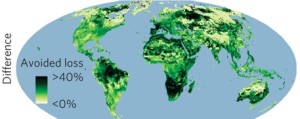We have much more to do and your continued support is needed now more than ever.
Climate Change Putting Even Common Plants and Animals at Risk

We already knew that the rising temperatures and shifting rainfall patterns brought about by climate change was bad news for the world’s rare and endangered species, likely pushing many to extinction. A new study published in the journal Nature Climate Change now finds that even their more common and widespread relatives are in danger. An international team of researchers, lead by the UK’s Tyndall Center for Climate Change Research, looked at nearly 50,000 plant and animal species worldwide and compared how their distributions align with current climatic conditions as well as possible future conditions.
They found that more than half of plants (57%) and more than a third (34%) of vertebrate animals would lose the majority of their climatically suitable habitats in the absence of serious actions to reduce carbon pollution.
Reductions in suitable climatic ranges for such a large number of the world’s plants and animals would not only lead to considerable losses of many unique life forms, but would have far-reaching and likely devastating effects on the many ecological benefits that people derive from our natural ecosystems.
Although comparisons between current species ranges and future climates have been carried out before, there are a couple of things that distinguish this new study.
- Scale – this research looked at a huge number of species around the world, focusing on those that currently are widespread and abundant.
- Dispersal capacity – Rather than assume that species would be capable of keeping pace with rapid shifts in climate (as many past studies have), the researchers incorporated estimates of realistic dispersal capacity for different groups of plants and animals.
- Carbon reduction – the researchers also evaluated the degree to which common species would suffer range contractions under various scenarios for carbon reduction, in order to quantify the biodiversity benefits of climate mitigation.
Understanding the implications for biodiversity of varying levels of carbon in the atmosphere takes on particular significance in the wake of last week’s news from the Mauna Loa Observatory that atmospheric carbon dioxide levels have topped 400 parts per million for the first time in at least three million years.
Providing More Time to Adapt
Dealing with the underlying cause of climate change (climate mitigation), and addressing the impacts of climate change (climate adaptation) have often been viewed as separate approaches to addressing global warming, and some environmentalists have even considered a focus on adaptation as undercutting the urgency of reducing carbon emissions. This study clearly demonstrates the tight and complementary relation between climate mitigation and adaptation efforts. These researchers found that early aggressive action on carbon reduction has the capacity to greatly reduce the projected impacts on common species—with losses reduced by 60% under the most stringent carbon reduction approaches. At the same time, reducing these pressures would have the effect of increasing the likely success of adaptation efforts, and lengthening the time—by up to 50 years—for society to put climate-smart conservation strategies into place.
Drawing on the Power of Networked Biological Data
This study was only possible thanks to an enormous investment over the past two decades to computerize and network together the world’s biological collections. Natural history museums and botanical gardens around the world have for centuries served as biological archives, with their preserved specimens documenting the distribution and condition of the world’s biological diversity. In order to make this historical record more accessible and useful to society, these institutions have been investing in the laborious task of digitizing these collections and linking them online in something called the Global Biodiversity Information Facility (GBIF). Indeed, the US node for this network—known as BISON—was just launched in April by the US Geological Survey. This global network now links together millions of plant and animal distribution records, and served as the primary source for the biological data on which this new and groundbreaking study of climate change was based. It is truly an example of how better access to the historical record can shed new light on the future of biodiversity.
Wildlife in a Warming World
Although this new study focuses on how these changes are likely to play out over the next 70 years, impacts of climate change on our wildlife are already here. National Wildlife Federation considers climate change to be the conservation issue of the twenty-first century, and recently issued a report—Wildlife in a Warming World—that details the many ways in which our wildlife already are being affected. In addition to advocating for meaningful action to reduce the carbon pollution driving global warming, NWF is working to identify ways to better safeguard our wildlife and their habitats in the face of climate change. There are many things that conservationists and natural resource managers can do now to help wildlife survive in the face of these threats, and our recently published Quick Guide to Climate Smart Conservation summarizes the findings of a broad collaboration of adaptation experts convened by NWF.
An Urgent Call to Action
While there is much that we can do to prepare for the impacts of climate change on people and wildlife, this new study makes clear that even with aggressive action – on both mitigation and adaptation—we stand to lose a substantial amount of our biological heritage. This has profound implications not only for the diversity of life on Earth, but for the very ecological life support systems, like water and food production, that humans rely on. The study underscores the urgency with which we need to achieve real and meaningful reductions in carbon emissions, if we wish to leave our children with a planet still capable of inspiring awe in our wildlife and wild places.
Speak Up for Polar Bear Cubs: Urge President Obama to start limiting carbon pollution that comes from coal fired power plants — our nation’s largest source of carbon pollution.






















